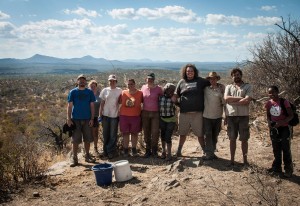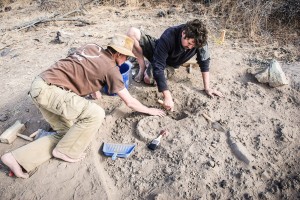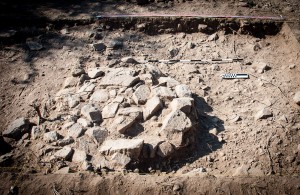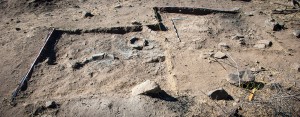[wunderslider_nggallery id=”5″ container_width=”100%” container_height=”300px” display=”proportional”]
Archaeological research at Maremani by the University of Pretoria
Background to Current Research
 Current archaeological research at Maremani by the University of Pretoria, primarily focusses on societies that settled in the area between AD 900 and AD 1400. Although human settlement of the area is much older, the region was sparsely populated during the preceding millennia. At around AD 900, farmers from the north moved into the Limpopo Valley and settled in the vicinity of the Shashe-Limpopo confluence area – around the present day Mapungubwe National Park. Excavations of their settlements show an affluent trade with Asia through ports on the African East coast. Around AD 1000, a new group of people moved into the Limpopo Valley, wresting away control of the trade and founding a new capital at the settlement known as K2. The inhabitants of K2 expanded the trade networks with the East coast – exchanging ivory, metals and skins for glass beads made in South East Asia. Increasingly though, K2 society became divided between elites – who had greater access to trade goods – and commoners.
Current archaeological research at Maremani by the University of Pretoria, primarily focusses on societies that settled in the area between AD 900 and AD 1400. Although human settlement of the area is much older, the region was sparsely populated during the preceding millennia. At around AD 900, farmers from the north moved into the Limpopo Valley and settled in the vicinity of the Shashe-Limpopo confluence area – around the present day Mapungubwe National Park. Excavations of their settlements show an affluent trade with Asia through ports on the African East coast. Around AD 1000, a new group of people moved into the Limpopo Valley, wresting away control of the trade and founding a new capital at the settlement known as K2. The inhabitants of K2 expanded the trade networks with the East coast – exchanging ivory, metals and skins for glass beads made in South East Asia. Increasingly though, K2 society became divided between elites – who had greater access to trade goods – and commoners.
By AD 1220, the elite settlement at K2 moves to a nearby hill known as Mapungubwe. Here, the social divide between elites and commoners becomes clear, with the royalty living on top of the inaccessible hill and the commoners living at the base. Elites also start using gold jewellery and large quantities of glass beads to signify their status. Political influence from the Mapungubwe capital stretched over a large area of northern South Africa, Eastern Botswana and Southern Zimbabwe.
Ongoing Research on Maremani
 It is during the early part of the second millennium AD that people with close ties to Mapungubwe settled in the area of what is today the Maremani Nature Reserve. Prior to the current research at Maremani, the role and political position of communities outside the core Mapungubwe area was difficult to establish. Research at Maremani has revealed a variety of trade items such as glass beads and marine shells. There is clear evidence of an indigenous cotton spinning industry and mining and smelting of locally available metals such as copper, iron and perhaps also gold.
It is during the early part of the second millennium AD that people with close ties to Mapungubwe settled in the area of what is today the Maremani Nature Reserve. Prior to the current research at Maremani, the role and political position of communities outside the core Mapungubwe area was difficult to establish. Research at Maremani has revealed a variety of trade items such as glass beads and marine shells. There is clear evidence of an indigenous cotton spinning industry and mining and smelting of locally available metals such as copper, iron and perhaps also gold.
The ongoing research on Mapungubwe settlements at Maremani also provides valuable information on the daily lives at these settlements. Most of their meat came from cattle and small stock such as sheep and goats. People also hunted wild animals such as zebra, hunted or snared duikers and springhares and caught birds. They also turned fragments of ostrich eggshell and giant landsnail shells into beads.
 As part of the Research at Maremani, archaeological scientists from the University of Pretoria and Yale University (USA) are currently exploring the use of a dating technique known as archaeomagnetism to date archaeological features at Maremani. This method uses the intensity and directional changes in the earth’s magnetic field to date soil samples that have been exposed to heat. Used in conjunction with traditional methods, such as radiocarbon, this exciting approach will enable a much higher chronological resolution of archaeological events than previously available in the Limpopo Valley.
As part of the Research at Maremani, archaeological scientists from the University of Pretoria and Yale University (USA) are currently exploring the use of a dating technique known as archaeomagnetism to date archaeological features at Maremani. This method uses the intensity and directional changes in the earth’s magnetic field to date soil samples that have been exposed to heat. Used in conjunction with traditional methods, such as radiocarbon, this exciting approach will enable a much higher chronological resolution of archaeological events than previously available in the Limpopo Valley.
Upcoming Research
Research has also begun on the interaction between Khoekhoe herders, Bushman hunter-gatherers and African farmers. With the expansion of trade since the end of the first millennium AD, a variety of items were transported through the Maremani region and Bushmen may have assisted in the movement and acquisition of wealth. Our research will focus on the impact of this on Bushmen culture: whether farmers paid them, acquired some of the wealth for themselves, slowly assimilated into surrounding society or avoided interactions altogether. Understanding these processes and occurrences will assist us in tracking changes in Bushman prehistory which, in the area around Maremani, ultimately led to their disappearance.
 One other aspect that this project will study is the role herders played in the region. Archaeologists believe that Khoekhoe herders arrived in southern Africa around 2000 years ago and left finger-paintings in various rock shelters. This art form has been identified in the Maremani Game Reserve, along with Bushmen paintings and engravings – and suggest that they too were living in the area. The archaeological identification of a herder presence is notoriously difficult and very seldom achieved, and at present has not been accomplished in northern South Africa. Therefore, the potential findings at Maremani might assist us in identifying herders in the archaeological record and allow us to explore the complex network of relationships occurring between Bushmen, herders and farmers around the development of the Mapungubwe state. There are few areas in southern Africa that can boast such an informative archaeological record.
One other aspect that this project will study is the role herders played in the region. Archaeologists believe that Khoekhoe herders arrived in southern Africa around 2000 years ago and left finger-paintings in various rock shelters. This art form has been identified in the Maremani Game Reserve, along with Bushmen paintings and engravings – and suggest that they too were living in the area. The archaeological identification of a herder presence is notoriously difficult and very seldom achieved, and at present has not been accomplished in northern South Africa. Therefore, the potential findings at Maremani might assist us in identifying herders in the archaeological record and allow us to explore the complex network of relationships occurring between Bushmen, herders and farmers around the development of the Mapungubwe state. There are few areas in southern Africa that can boast such an informative archaeological record.
For more information about the ongoing project;
Proposal for research – University of Pretoria Fieldschool Project – _Maremani

